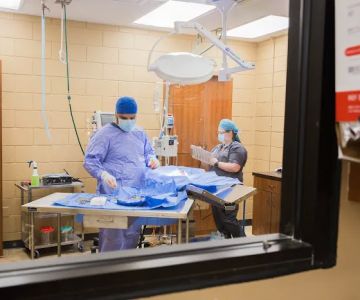Emergency First Aid for Pets: A Comprehensive Guide to Handling Pet Emergencies
- 1-Understanding Emergency First Aid for Pets
- 2-Common Pet Emergencies and How to Respond
- 3-Essential First Aid Supplies for Pets
- 4-Steps to Take During Pet Emergencies
- 5-When to Call a Veterinarian in an Emergency
- 6-Why Choose Hidden Brook Veterinary for Your Pet's Needs
1. Understanding Emergency First Aid for Pets
Accidents and emergencies can happen at any time, and when they involve our pets, it's crucial to act quickly and correctly. Emergency first aid for pets refers to the immediate care and interventions provided to an injured or ill pet before professional veterinary help can be obtained. Knowing how to respond to common pet emergencies can save a pet's life and reduce the severity of injuries until you can get them to a veterinary clinic.
Much like humans, pets are vulnerable to a range of emergencies, including choking, burns, poisoning, and injuries. Quick thinking, calmness, and a basic understanding of first aid can make all the difference. Pet owners must be equipped with knowledge about how to manage these situations, as time is often of the essence. This article will guide you through essential steps for performing first aid on pets, outline common pet emergencies, and provide you with practical tips for preparing yourself and your pet for any situation.
2. Common Pet Emergencies and How to Respond
There are several types of emergencies that pet owners should be prepared to handle. While the list is not exhaustive, these are the most common situations in which first aid for pets is required:
2.1. Choking
Choking occurs when an object blocks the airway of a pet, preventing them from breathing. If your pet is choking, they may cough, paw at their mouth, or show signs of distress. To help, try to keep your pet calm and check if the object is visible in their mouth. If it is, gently try to remove it with your fingers. If the object is not visible, perform the Heimlich maneuver (abdominal thrusts) or seek immediate veterinary assistance. Quick action is critical, as choking can cause suffocation if not treated promptly.
2.2. Poisoning
Poisoning is a serious emergency for pets and can occur if they ingest harmful substances like chocolate, plants, or chemicals. Signs of poisoning include vomiting, diarrhea, drooling, or lethargy. If you suspect poisoning, immediately contact a veterinarian or poison control. In some cases, you may be advised to induce vomiting (but only if instructed by a professional), or your vet may provide an antidote or other treatments. Quick identification of the substance is crucial for proper treatment.
2.3. Bleeding and Wounds
If your pet is bleeding, it’s essential to stop the bleeding as quickly as possible. Apply direct pressure to the wound using a clean cloth or bandage. If the bleeding is severe or doesn’t stop after a few minutes, seek emergency veterinary care. For puncture wounds, clean the area with water, apply antiseptic, and cover it with a sterile bandage to prevent infection.
2.4. Burns
Burns can be caused by hot surfaces, chemicals, or fire. If your pet suffers from a burn, you should immediately cool the affected area with cold water (not ice) for several minutes. This helps to reduce pain and prevent the burn from worsening. Avoid using ointments or creams unless directed by a vet, as these can sometimes make the situation worse. Burns should be evaluated by a veterinarian as soon as possible.
3. Essential First Aid Supplies for Pets
Being prepared for pet emergencies means having the right first aid supplies on hand. While you can’t predict when an emergency will happen, having a well-stocked first aid kit for pets can ensure that you’re ready to act quickly. Here are some essential items to include in your pet’s first aid kit:
3.1. Bandages and Gauze
Bandages and gauze are essential for stopping bleeding and covering wounds. You’ll want to have several sizes of self-adhesive bandages and sterile gauze pads to apply pressure to wounds and cover injuries.
3.2. Antiseptic Solution
Cleaning wounds to prevent infection is vital. Include an antiseptic solution or wipes that are safe for pets, such as iodine-based solutions or chlorhexidine, to clean cuts, scrapes, and burns.
3.3. Tweezers
Tweezers are helpful for removing splinters, ticks, or other foreign objects embedded in your pet’s skin. Be sure to use a pair of sterilized tweezers to avoid introducing bacteria into the wound.
3.4. Thermometer
A thermometer is a basic yet essential tool for checking your pet’s temperature if they are feeling unwell. Normal body temperature for pets is usually around 101-102.5°F (38-39°C), and any significant deviation can indicate a health problem.
3.5. Emergency Contacts
It’s essential to have emergency contact information in your first aid kit, including your veterinarian’s phone number and the number for the nearest emergency veterinary clinic or poison control hotline. This ensures that you can quickly get help when needed.
4. Steps to Take During Pet Emergencies
In the event of a pet emergency, every second counts. Knowing what steps to take during an emergency can help you stay calm and provide the best care possible for your pet. Follow these general steps in any emergency situation:
4.1. Stay Calm and Assess the Situation
The first thing you should do is stay calm. Panic can cloud your judgment and hinder your ability to act effectively. Take a moment to assess the situation, determine the severity of the emergency, and figure out the best course of action.
4.2. Perform Immediate First Aid
Once you’ve assessed the situation, perform the necessary first aid to stabilize your pet. For example, apply pressure to bleeding wounds, induce vomiting if instructed by a professional (for poisoning), or remove any visible objects causing choking. Ensure that your actions align with the pet emergency first aid protocols you’ve learned.
4.3. Contact a Veterinarian
Even if you’ve administered first aid, you should contact your veterinarian or emergency veterinary clinic immediately for further instructions. Let them know what steps you’ve already taken, and follow their advice on what to do next.
4.4. Transport Your Pet to the Vet
If your veterinarian instructs you to bring your pet in for further treatment, do so immediately. Be sure to transport your pet safely, keeping them as comfortable as possible, and try to limit any movement that might aggravate their condition.
5. When to Call a Veterinarian in an Emergency
Not all pet emergencies require immediate veterinary attention, but in many cases, it's best to err on the side of caution. Here are some situations when you should call a veterinarian:
5.1. Difficulty Breathing or Choking
If your pet is struggling to breathe or is showing signs of choking, you should contact your vet immediately. These are critical situations that may require immediate intervention to prevent suffocation.
5.2. Severe Bleeding
If your pet is bleeding profusely and first aid measures aren't stopping the flow, it’s time to call a vet. Severe bleeding can lead to shock or other life-threatening conditions.
5.3. Seizures
Seizures can be a sign of a serious underlying condition. Even if your pet seems to recover quickly, it’s important to have them evaluated by a veterinarian to ensure their health and safety.
5.4. After Handling Poisoning
If your pet ingests something toxic, you should call your vet or poison control right away. They can provide advice on whether to induce vomiting or take other steps.
6. Why Choose Hidden Brook Veterinary for Your Pet's Needs
At Hidden Brook Veterinary, we understand the importance of emergency care for your pets. Our team is committed to providing comprehensive and compassionate care during emergencies. Whether your pet requires urgent treatment or a routine checkup, we’re here to help ensure their health and safety. Visit us today to learn more about our services and how we can support your pet’s well-being in times of need.











